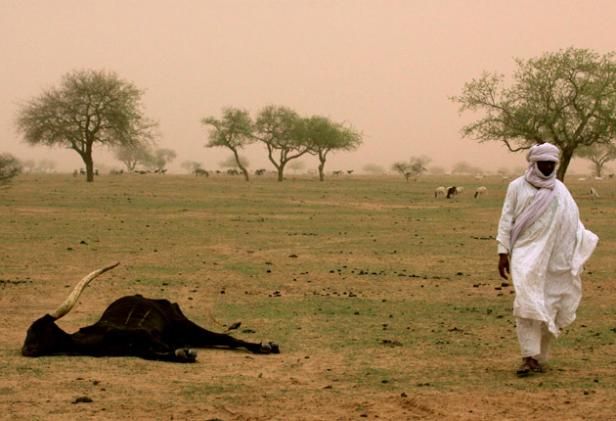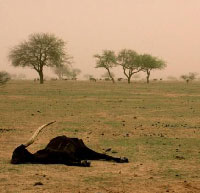Worldwide studies show that a half-century of heavily mechanized, chemical-intensive monocrop agriculture has severely depleted soil humus (Lal, 2011; Ruddiman, 2003). Humus is the organic complex of soil organic carbon, nitrogen, and phosphorous, along with all other necessary nutrients to sustain soil life and plant growth. Densely populated by soil microbes, humus is more than only soil organic carbon (SOC), which is however, its most important component (approximately 60% of humus is SOC). Today, soil humus depletion is approaching levels that cannot be compensated for by higher amounts of fertilizer. In many places, this has already led to reduced harvests (Lal, 2006). Despite these alarms, the loss of humus in agricultural soils proceeds unabated. Although scientifically substantiated measures to prevent the loss of soil carbon and rebuild soil humus content are well known, no country in the world has yet included the protection of soils and ecosystems as a top priority. Despite the fact that agriculture is heavily dependent on subsidies in all more developed countries, there are no incentives in place to initiate the build up of soil fertility and soil organic matter.

The Sahel was once fertile land and an important zone of agriculture. Erosion, overgrazing, humus loss and climate change brought desertification.
Since the dawn of agriculture more than 10,000 years ago, estimates are that soils have lost between 55 (IPCC, 2014) and 320 billion tons of carbon (Ruddiman, 2003). This corresponds to a 25% to 75% loss of the original humus content (Lal, 2011). Most of that lost soil carbon was transformed to CO2, ending up in the atmosphere or in the oceans and thus has had a significant impact on climate change.
Humans are capable of both creating and destroying humus. The Sahel was once a fertile agricultural region, but overgrazing, erosion, humus depletion and climate change have devastated most of the area today. A healthy soil has humus levels between 3.5% and 6%. This, however, can only be obtained by closing organic cycles, applying organic matter (composts, green manure and mulch), mixed cropping, continuous soil cover and minimizing tillage. Impressive results can be achieved by adopting such practices: the humans who created the Terra preta soils of the Amazon built a humus content of 10% to 15% (Glaser and Birk, 2012; Glaser et al., 2001), in a region where heat and high rainfall degrade humus quickly, resulting in native soils naturally low in carbon. Many examples throughout the world demonstrate that this is possible everywhere (Wiedner et al., 2014).
Soils under industrialized agriculture are rapidly losing humus. Frequent tillage and soil compaction, semi-seasonal bare soil, monocultures without crop rotation and without hedgerows, use of herbicides and synthetic mineral fertilizer, deforestation and burning of waste biomass (both crop residues and animal manure) can all lead to loss of topsoil. The most intensively used agricultural soils in temperate climates of Central to Southern Europe, Asia and North America often have humus values of below 2%, with many areas already significantly below 1% (with some notable exceptions).
The frequency and severity of dust storms have increased since the invention of the tractor and the mechanization of tillage, starting with the Great Plains of the United States (the 1930s Dust Bowl). Dust storms regularly darken the skies over Beijing and large parts of Eastern Asia, obscuring the sun for days at a time. A deadly automobile pile-up on an Autobahn in Northern Germany in April 2011 had the same cause: wind erosion of bare farmland without hedgerow protection. Same errors repeated all over again and again.

Storms of dust have spread since the invention of the tractor and the mechanization of ploughing and monoculture, from the American Midwest to most of the intensively cultivated flat plains of the world.
The critical level of humus content, where yields start to decrease significantly, stands at about 3.5% in the temperate zones (Lal, 2006; Kemper et al., 1966; Loveland et al., 2003) and at 2% for most tropical soils (Aune & Lal, 1997). Below these limits water storage capacity of the soil quickly declines, reducing the ability of plants to survive long dry periods. The nutrient storage capacity of the soil decreases just as rapidly, which means that fertilizers are more easily leached out or volatilized and are no longer available to plants and symbiotic microorganisms in sufficient quantities (Lal, 2006). Decreasing organic matter content decreases the capacity of the soil to resist pests and break down pollutants. Plants grown in such depleted soil are also more susceptible to pests and diseases.
To maintain crop yields under these conditions, more fertilizer, specially bred (hybrid) seeds and increasingly strong pesticides are required. This dynamic has a parallel in the field of medicine. Just as the pharmaceutical industry achieves its highest profits among the chronically ill with a long life expectancy, so the agrochemical industry derives its highest profits from administering ever-increasing doses of agrochemicals to depleted soil under industrial management.
But while relatively stable harvests can still be achieved using the prescribed agrochemical cocktail in temperate climates with soil organic matter content of 1 - 1.5%, it is plainly no longer possible in the tropics when humus content drops below 1%. The harvests decline from year to year until finally traditional farming is no longer possible, the soils are devastated and the peasants lose their self-sufficiency.
In Kenya, some agricultural areas have lost 50 to 75 metric tons of carbon per hectare corresponding to 4% - 6% of humus content over 30 years (sources in Lal, 2006). In Senegal, the humus content in the upper 10 cm of the soil fell from above 5% to 1.8% between 1880 and 1970 (Siband, 1974). This scenario stretches across the entire African continent and also over Southeast Asia and Latin America. Almost 90% of the one billion hungry people live in those climates where the humus content has dropped below the critical limit and where, consequently, there is no longer sufficient income to support rural residents.
More humus in the soil, more grain in the mill
Rattan Lal of the Carbon Management and Sequestration Center in Columbus, Ohio, one of the most persistent researchers in this field, found, after more than 35 years of extensive field studies and data collection in Africa, Central America and South East Asia, that harvest volumes increase linearly when humus content increases within the critical range up to 3% soil humus. It is not the mechanical and chemical intensification of agriculture, as industry and politicians still stubbornly and cynically claim, but the increase of humus through sustainable agricultural practices that can secure the food supply for a growing world population.
Through an annual increase of humus content in the root zone of 1 ton of carbon per hectare per annum (about 0.07% humus in the upper 20 cm of soil), grain production could be increased in developing countries by an additional 32 (+/-11) million tons a year (Lal, 2006). This amount corresponds to the food needs of 150 million people. Each additional ton of carbon in a hectare of agricultural land in the tropics and subtropics could raise yields by an average of 20-70 kg/ha wheat, 10-50 kg/ha of rice, 30 to 300 kg/ha of maize and 40-60 kg/ha beans (Lal, 2006).
An increase in humus content of agricultural soils of 0.07% per annum can be reached efficiently with climate farming, a method developed at the Ithaka Institute and described in the following section. This amount of increase is most likely quite conservative. If these methods are fully implemented, an even higher increase may be expected.
The climate farming method
The methods of climate farming are widely used in traditional, good agricultural practices, though elements used will vary in different regions and different cultures. Most of the methods are used and have been further developed by permaculture, conservation farming, regenerative or eco-agriculture, and “regrarianism.” Parallel to the climate farming, concept similar concepts have appeared under the name of carbon farming. The differences are minimal and the objectives the same. In addition, our use of the term “climate” in “climate farming” is not restricted to the impact of carbon transfer from the atmosphere to the soil and to new grown plants, but also includes the social climate of farming.
The following nine methods have been scientifically proven, but have largely disappeared from industrial practice in the last 50 to 100 years due to the lower cost of energy inputs and different farming priorities. Thanks to advancing knowledge about soil biology and cycling of carbon, nitrogen and other nutrients, these traditional methods are being recovered, optimized and adapted to different site conditions. The following elements seem essential:
- Permanent soil cover. The soil should never be naked. Nude soils promote erosion, evaporation of soil water, leaching and outgassing of nutrients; they weaken soil biodiversity and the nutrient base of the plant symbionts; they reduce capacity of the ground for assimilation of atmospheric carbon, nitrogen and water. Soil cover can be achieved by means of mulching crop residues or green manure systems.
- Undisturbed soil layers. Use low or minimum tillage to maintain the soil structure and prevent compaction. Tilling and inverting soil layers exposes organic matter to oxidation, converting it to CO2 lost to the atmosphere. It also disturbs complex soil ecosystems, impoverishing the soil food web. (Some recent studies, however, suggest that some tillage might help to increase humus depending on the soil type and initial soil organic matter.)
- Closed nutrient cycles. Use crop residues, compost, animal and human manure. Return the nutrients that have been removed from the soil. Use biochar to optimize the nutrient cycling processes.
- Carbon and mineral amendments. Amending the soil with labile carbon (mulched stover, compost and manures), recalcitrant carbon (biochar) and minerals (powders of basalts, tuff, granites, and pyroclastic materials, plant extracts and seawater concentrates) provides both added carbon and minerals for photosynthetic and plant-building processes and biologically-beneficial structure for the soil. (Goreau, 2014)
- Polycultures and agroforestry. Diverse mixed plantings promote soil biodiversity, improving biological nutrient fixation and increasing disease resistance of the agro-ecosystem. Agroforestry prevents erosion, makes better use of the various soil horizons and increases assimilation of atmospheric carbon that accumulates in the soil. Agroforestry also takes advantage of nature's natural succession processes, which occur below the ground as well as above it.
- Legume rich green manures as cover cropping or under-sowing. This practice promotes biological nitrogen fixation, formation of soil aggregates, and increased biomass production.
- Crop rotation. Using a minimum three-field rotation system and mixed cropping increases biodiversity, reduces pests and increases soil mineral availability and the diversity of organic carbon inputs through root exudates, symbiotic diversity and root decomposition.
- Water management. Water is one of the limiting factors for both plant growth and for the biological activity of the soil, which is critical to humus formation. Target irrigation to the root zone using rainwater recovery and natural water retention. "Stop, spread and sink" rainfall using techniques such as keyline management, swales, wetlands, and diversion. Optimize soil water holding capacity, taking advantage of biochar and compost for this purpose.
- Livestock. Include grazing animals as part of the crop rotation to enrich soil biology and reduce pests. Biochar as feed additive may not only improve the nutrient efficiency but also amend the soil with organically enriched biochar.
Please note that biochar is not a single climate farming method in itself but an important factor to optimize the humus building capacity of several of the methods.
Building humus reduces the CO2 content of the atmosphere
Increasing the carbon content of the soil by 10% worldwide in the next 100 years could sequester the equivalent of 900 billion tons of CO2 in the soil (Lal, 2011). This could reduce the CO2 content of the atmosphere by up to 110 ppm, so that, if industrial emissions are controlled, the CO2 level might even fall back to pre-industrial levels.
Soil sequestration of carbon through agriculture is therefore, according to McKinsey & Co. (2009), the most cost-effective way to reduce the CO2 content of the atmosphere, as compared to the expensive CCS (Carbon Capture and Storage) methods for separation of CO2 from flue gas and storing it underground. The latter is estimated at $60 - $100 per ton of CO2, which is likely a low estimate. Norway’s StatoilHydro projected the cost of its initial project to be as high as $203- $281 per ton of captured CO2 (Reuters, 2009).
Should farmers be able to increase levels of humus at the rate of 0.07% per year (1 t C/ha) as outlined above, and if prices like those estimated for CCS would be paid, farmers could anticipate per hectare annual revenues of between $210 and $360 (McKinsey) just for carbon abatement. For many farmers in the tropics and subtropics, this would be more income than they have ever earned with any crop on a per hectare basis. But above all, their soils would once again provide enough food to feed their children.
What is it worth for you that this article exists? All of our articles are open source, based on experience and scientific research, reviewed by renowned scientists, independent and free from ads. Please help finance our work with a subscription or a donation to the Biochar Journal. subscribe here
Literature
Please find the complete list of references here.


- Please write us your comment -
×